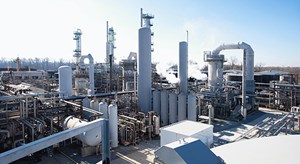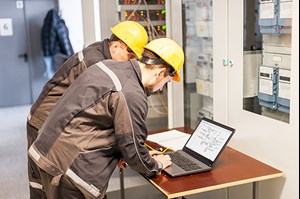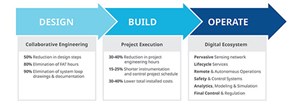Articles
Next-generation automation technology paves the way for sustainable H2 manufacturing
Digital Technologies
N. PETTUS, Emerson, Austin, Texas
In the last few years, sustainability initiatives have started a dramatic shift from hydrocarbon to hydrogen (H2) production. While these initiatives have put pressure on hydrocarbon processing plants, the shift to H2 has, for many, been a natural transition. A vast amount of infrastructure and knowledge is already in place for producers to shift to H2 as a more sustainable alternative.
However, manufacturers making this shift face two major challenges. First, with companies making 100% net-zero commitments within the next decade or two, the timeline to build a new plant or modernize an existing one is highly compressed. Additionally, once the plant is operational, H2 producers are being asked to rapidly increase production, while still improving the manufacturing process to reduce emissions and energy use (FIG. 1).

The solution to these challenges is modern automation technology. With next-generation automation systems and industrial software, H2 manufacturers can reduce their time to startup, increase production, improve efficiency and help the world achieve its collective net-zero targets.
Capturing value with modern control. Large-scale H2 plants are complex, with a wide array of equipment and complicated processes, each needing constant visibility and attention. This complexity is compounded by the fact that many organizations are facing a shortage of experienced operations personnel.
A powerful distributed control system (DCS) that is connected with homogeneous smart devices and Internet of Things (IoT) technologies provides assistance by bringing complex, variable data into one place—thus increasing operator efficiency. Furthermore, this technology helps organizations standardize operations across a fleet of facilities, enabling personnel to easily move between locations without needing to retrain.
Additionally, a high-performing DCS reduces project integration time and cost by combining user-friendly integration tools with a framework for standardized equipment data models and description languages. A best-in-class DCS also decreases downtime and maintenance troubleshooting because both machine and process control systems become more reliable.
Some automation suppliers have even developed compact standalone controllers that provide smarter control for skid units and applications, such as polymer electrolyte membrane and alkaline electrolyzers. These units provide the full benefits of control while operating in standalone mode, and can be natively integrated into a full control system at any time as the plant scales.
Extending the value of the DCS with advanced process control (APC). The complexity of H2 operations increases if producers are simultaneously performing carbon capture steps to reduce emissions from their manufacturing processes. Under these conditions, it is difficult to accurately predict process failures, particularly if different operators make manual adjustments.
To remove the variability and guesswork of predicting process failures, many H2 producers embed APC into their control systems. APC applies software logic to help operations teams take full advantage of today’s process control capabilities.
Tools like loop monitoring, adaptive tuning, quality prediction, constrained optimization and statistical modeling provide improved predictive control. Operators using these and other APC tools are no longer responsible for controlling every element of the process; instead, they are freed to act more as process managers, intervening only when necessary.
APC empowers operations teams to run their H2 processes with more consistency and less firefighting. Using APC, processes begin operating within much narrower bands, making them far more predictable. These same benefits also deliver improved reliability, as equipment is no longer subject to the same swings that come in a less tightly controlled environment, so assets experience less wear and tear.
In addition, because the process stages and thresholds are built into software logic, teams can often safely run their processes much closer to constraint limits, thereby increasing efficiency and profitability across the operation. These benefits can be extended to more than just a single-unit operation. Once a plant with multiple-unit operations has optimized each loop to perform at its best, the plant’s personnel can optimize all loops together into an overarching APC strategy that will synchronize all operations.
Improving uptime and operational outcomes with asset monitoring software. Another technology that enables more efficient and sustainable H2 production is intelligent sensing devices. Smart wireless sensors provide data, which, in some cases, is analyzed using artificial intelligence (AI) and machine-learning, making it easier than ever for key personnel to be notified when something needs attention. This awareness translates directly into savings in the H2 industry, where essential equipment is expensive and complex. Fixing an asset that has run to failure typically costs 50% more than the preemptive repairs made possible with the continuous visibility provided by intelligent sensing devices.
Operations and maintenance teams have taken note of the benefits from this type of predictive analytics and are deploying vast numbers of sensors to capture these savings. Moreover, sustainability and reliability are linked. Unreliable equipment typically uses more energy and generates more emissions. By leveraging asset monitoring technologies to ensure that equipment always runs at its best, manufacturers can further increase the availability of plant assets as well as the sustainability and the production of their operations.
Driving optimization through simulation. Two major risks facing greenfield and brownfield H2 projects are cost overruns and schedule delays. The more unknowns that exist in project design, the more likely it is that the plant will not start up on time due to late-stage changes. Today’s forward-thinking project teams are circumventing these problems by designing simulation technology into the earliest stages of a project.
Using simulation and digital twin technologies, project teams can create digital replicas of the entire H2 plant and its individual processes. With these simulated environments, teams can test equipment to ensure that it meets specifications, check processes to identify flaws and bottlenecks, and develop new advanced control strategies—all in a safe environment and long before equipment arrives onsite. The operations team can better fine-tune processes and optimize control strategies, all before “day one” of the physical startup (FIG. 2).

Because digital twin systems are replicas of the entire plant, including the automation system, they can also be used as training tools in parallel with project implementation. Operators can train on new systems as they are being built, experiencing the same scenarios they will see in live operation. As they practice, the responsive controls of digital twin systems show operators exactly how their actions cascade across the plant. This helps operators to better understand the repercussions of every action and prepares them to make the best decisions from the earliest days of operation. Training can typically begin well before equipment is even onsite, often shaving weeks or months off the startup time vs. traditional training methods.
When projects are complete, those same digital twin technologies continue to deliver value. The best processes are the ones that continue to evolve, adopting new strategies and technologies across the lifecycle to optimize operations. A well-maintained digital twin mirrors the plant as it changes across the lifecycle, providing operations with a sandbox environment to test operational changes. Knowing that they have a safe environment in which to test, operators are free to innovate new strategies, which helps to drive the best possible performance throughout the lifecycle of the plant.
Driving a more holistic automation architecture. To ensure that all the critical components of H2 production work together, operations teams need cross-domain visibility. However, traditional automation architectures often trap information from different domains in silos, limiting plant efficiency.
Forward-thinking automation providers are changing this paradigm by developing holistic industrial architectures that integrate operational domains. These holistic architectures are centered around a next-generation, software-defined control system that uses modern technologies to contextualize and democratize data, driving insights from the field through the edge and to the cloud (FIG. 3).

Not all the elements to build this boundless automation architecture are available today. However, some of the foundational elements are, and innovative H2 producers are already putting key industrial software solutions in place to prepare for the inevitable future of a more holistic automation architecture.
Achieving net-zero targets. Scaling H2 production to meet aggressive sustainability targets is a daunting task. Fortunately, with modern automation technology, H2 producers can reduce startup time, increase production, improve efficiency and help the world achieve critical net-zero targets.H2T
About the author

NATHAN PETTUS is the President of Emerson’s Process Systems and Solutions business. He oversees a business that helps some of the world’s leading companies—in a wide variety of industries—leverage automation software and technologies to optimize operations, protect personnel and reach sustainability targets. Pettus has been with Emerson since 1998, when he began as a software engineer. He earned a Bch degree in mechanical engineering from Tennessee Technological University, an MS degree in controls engineering from the University of Texas at Austin and an MBA degree from the McCombs School of Business at the University of Texas at Austin.

